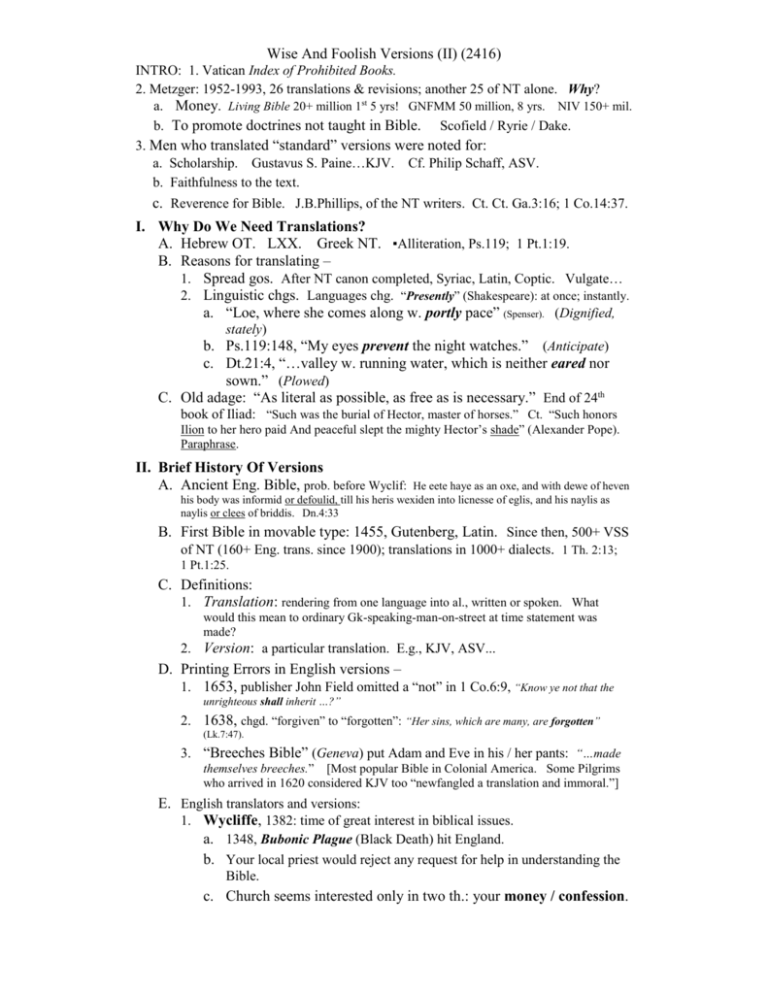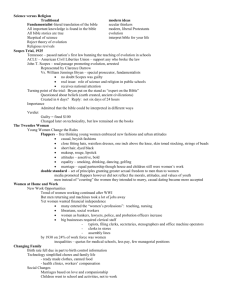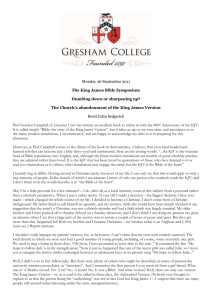Notes 2416 - RD Sermons
advertisement

Wise And Foolish Versions (II) (2416) INTRO: 1. Vatican Index of Prohibited Books. 2. Metzger: 1952-1993, 26 translations & revisions; another 25 of NT alone. Why? a. Money. Living Bible 20+ million 1st 5 yrs! GNFMM 50 million, 8 yrs. NIV 150+ mil. b. To promote doctrines not taught in Bible. Scofield / Ryrie / Dake. 3. Men who translated “standard” versions were noted for: a. Scholarship. Gustavus S. Paine…KJV. Cf. Philip Schaff, ASV. b. Faithfulness to the text. c. Reverence for Bible. J.B.Phillips, of the NT writers. Ct. Ct. Ga.3:16; 1 Co.14:37. I. Why Do We Need Translations? A. Hebrew OT. LXX. Greek NT. ▪Alliteration, Ps.119; 1 Pt.1:19. B. Reasons for translating – 1. Spread gos. After NT canon completed, Syriac, Latin, Coptic. Vulgate… 2. Linguistic chgs. Languages chg. “Presently” (Shakespeare): at once; instantly. a. “Loe, where she comes along w. portly pace” (Spenser). (Dignified, stately) b. Ps.119:148, “My eyes prevent the night watches.” (Anticipate) c. Dt.21:4, “…valley w. running water, which is neither eared nor sown.” (Plowed) C. Old adage: “As literal as possible, as free as is necessary.” End of 24th book of Iliad: “Such was the burial of Hector, master of horses.” Ct. “Such honors Ilion to her hero paid And peaceful slept the mighty Hector’s shade” (Alexander Pope). Paraphrase. II. Brief History Of Versions A. Ancient Eng. Bible, prob. before Wyclif: He eete haye as an oxe, and with dewe of heven his body was informid or defoulid, till his heris wexiden into licnesse of eglis, and his naylis as naylis or clees of briddis. Dn.4:33 B. First Bible in movable type: 1455, Gutenberg, Latin. Since then, 500+ VSS of NT (160+ Eng. trans. since 1900); translations in 1000+ dialects. 1 Th. 2:13; 1 Pt.1:25. C. Definitions: 1. Translation: rendering from one language into al., written or spoken. What would this mean to ordinary Gk-speaking-man-on-street at time statement was made? 2. Version: a particular translation. E.g., KJV, ASV... D. Printing Errors in English versions – 1. 1653, publisher John Field omitted a “not” in 1 Co.6:9, “Know ye not that the unrighteous shall inherit …?” 2. 1638, chgd. “forgiven” to “forgotten”: “Her sins, which are many, are forgotten” (Lk.7:47). 3. “Breeches Bible” (Geneva) put Adam and Eve in his / her pants: “…made themselves breeches.” [Most popular Bible in Colonial America. Some Pilgrims who arrived in 1620 considered KJV too “newfangled a translation and immoral.”] E. English translators and versions: 1. Wycliffe, 1382: time of great interest in biblical issues. a. 1348, Bubonic Plague (Black Death) hit England. b. Your local priest would reject any request for help in understanding the Bible. c. Church seems interested only in two th.: your money / confession. d. Into this setting walks Wycliffe, Ro. Cath. priest; does not hesitate to speak ag. excesses of Church. “Morning star of the Reformation.” e. He circulated first complete English Bible. f. Completed translation 70+ yrs before invention of printing press; all Wy. Bibles = handwritten. A Bible could take year to copy; they made thousands. g. Mt.8:23-27: “And Jhesu steyinge vp in to a litel ship, his disciplis sueden him. And loo! A grete steryng was made in the see, so that the litil ship was hilid with wawis; but he slepte. And his disciplis camen nigh to hym, and raysiden hym, sayinge, Lord, saue vs: we perish-en. And Jhesus seith to him, What ben yhee of litil feith agast? Thanne he rysynge comaundide to the wyndis and the see, and a grete pesiblenesse is maad. Forsothe men wonderden, sayinge: What manere man is he this, for the wyndis and the see obeishen to hym.” 2. Tyndale, 1526. First to translate fr. Heb. & Gk. 92% of KJV fr. Tyn. 3. 4. 5. 6. 7. 8. 9. 10. 11. 12. 13. 14. 15. 16. 17. 18. Condemned for heresy; Oct.6, 1536: strangled & burned. Last words: “Lord, open the King of England’s eyes.” [Lord had already done so. Months before his death, Henry auth. Great Bible] History: a. Invention of the movable-type printing press (c. 1455). Tyndale’s was the first English NT printed after the age of printing. b. 1453: Turks invade Byzantium. Greek scholars fled w. MSS to Europe. 1458: Greek is offered for the first time at European university; led to first published Greek NT, Mar.1, 1516. c. 1539: Henry VIII allows printing of Great Bible, based largely on Tyndale’s work. Coverdale, 1535. First complete printed Bible in English. Matthew's Bible, 1537. John Rogers [1555, became first martyr burned at stake under Mary Tudor (“Bloody Mary”) Catholic monarch]. Great Bible, 1539, named for size (15" x 9+"). Authorized Bible (Henry 8th). Geneva Bible, 1560. Pilgrims, Shakespeare. First to use verse div. Bishops’ Bible, 1568. Revision of Geneva. 2nd authorized version. Douay, 1609. R. Cath. attempt to counteract infl. of other versions. King James, 1611. 3rd AV. James Stuart of Scotland. 47+ scholars. English Revised Version, 1881-1885. Sold 3 million copies first yr. Chicago Tribune / Times published NT May 22, 1881 issues, part of it telegraphed from NY. American Revised Version, 1901. Revised Standard Version, 1946, 1952. New English Bible, 1961. New American Standard Bible, 1963, 1971. New International Version, 1973. New King James Version, 1982. CEV, 1995. English Standard Version, 2001. III. How To Know Which Version To Use? A. Scholarship – Ind. or group? Robt. Bratcher, TEV, Ac.20:7 – Sat. evening; fel. meal. 1. 7, records Roman time (next day; midnight). Gentile territory. Midnight = Monday. Cf. v.11, daybreak. [Cf. Lk.24:1] 2. 11, Paul alone ate (he). Fellowship meal? 3. 11, talked, , not same word as v.7 and 9 (). The assembly is over. B. Translation or paraphrase? Two basic approaches: 1. Formal Equivalence - attempts to translate words and nuances of the original as literally as possible, provided that no actual violence is done to English usage. Weigle of Yale & F.F.Bruce, promoters of modern versions, conceded ERV/ASV were the most meticulously accurate versions in English. 2. Dynamic Equivalence - attempts to convey the meaning of text in free and idiomatic English with less regard for exact wording of original a. Many commentaries come disguised as translations. b. Four types of translations: literal, standard, thought, paraphrase. C. Theological bias? “LIMITS OF SYNTAX. After all is done, instances remain where syntax cannot say the last word, where theological bias will inevitably determine how one interprets the Greek idiom . . . So in Ac. 2:38 does not of itself express design (see Mt.10:41), but it may be so used. When the grammarian has finished, the theologian steps in, and sometimes before the grammarian is through” (A. T. Robertson, Grammar … 389). 1. A Manual Grammar Of The Greek New Testament, Dana and Mantey, under , 103f.: “Remote meanings: . . . (7) Because of.” Mantey personifies Robertson’s remark; he tries to justify the causal use of by appealing to parallels in classical literature. Ralph Marcus exposed him in J B L, 1951/52 (Edward Hobbs) . 2. J. H. Thayer obtained permission fr. Prof. Grimm to make changes in his work that might better adapt it to needs of English speaking students, placing additions in brackets ( [ ] ). Consider , pp.94-95: 3. of Christian baptism; this, according to the view of the apostles, is a rite of sacred immersion, commanded by Christ, by which men confessing their sins and professing their faith in Christ are born again by the Holy Spirit unto a new life, come into the fellowship of Christ and the church (1 Co. xii. 13), and are made partakers of eternal salvation; [but see art. “Baptism” in BB.DD., McC. and S., Schaff-Herzog]: Eph. iv. 5; Col. ii. 12 . . .. [When lexicons agree…] D. How does it differ fr. ASV/NKJV? Ro.3:28, “For we conclude that a man is put right with God only through faith, and not by doing what the Law commands.“ (TEV) Ro.1:17, “For the gospel reveals how God puts men right with himself: it is through faith alone, from beginning to end. As the scripture says, 'He who is put right with God through faith shall live.’” (TEV) E. Does it teach doctrinal error? “But I shall remain at Ephesus until Whitsuntide, for a great opportunity has opened for effective work, and there is much opposition” (NEB, 1 Co.16:8-9). IV. The King James Version A. Revision of Bishop’s Bible of 1568. KJV was revised in 1615, 1629, 1638, 1762, and 1769 (the revision used today). From 1611–1769, almost 100,000 chgs in KJV. Six groups: Westminster, Cambridge, Oxford. B. Some words chgd. meanings since 1611. Gay. Blackberry. Twitter. 1. Ps.4:2, leasing = lying. 2. Mt.3:15, suffer = allow. 3. Mk.6:25, charger = platter. 4. Lk.15:8, candle = lamp. 5. Lk.17:7, by and by = immediately. 6. Ac.17:3, allege = prove. 7. Ac.21:15, carriages = baggage. 8. Ac.28:13, fetched a compass = sailed around. 9. Ro.1:13, let = hinder. 10. 1 Co.13:1-3, charity = love. 11. 2 Co.8:1, do you to wit = make known to you. 12. Ga.6:6, communicate = share with. 13. Ph.1:27, conversation = conduct. 14. 1 Th.4:15, prevent = precede. Choosing a good translation can be tricky business. This lesson tries to explain why. [Versions; respect for Bible; Wycliffe; Tyndale; paraphrase; bias; KJV; words change]









